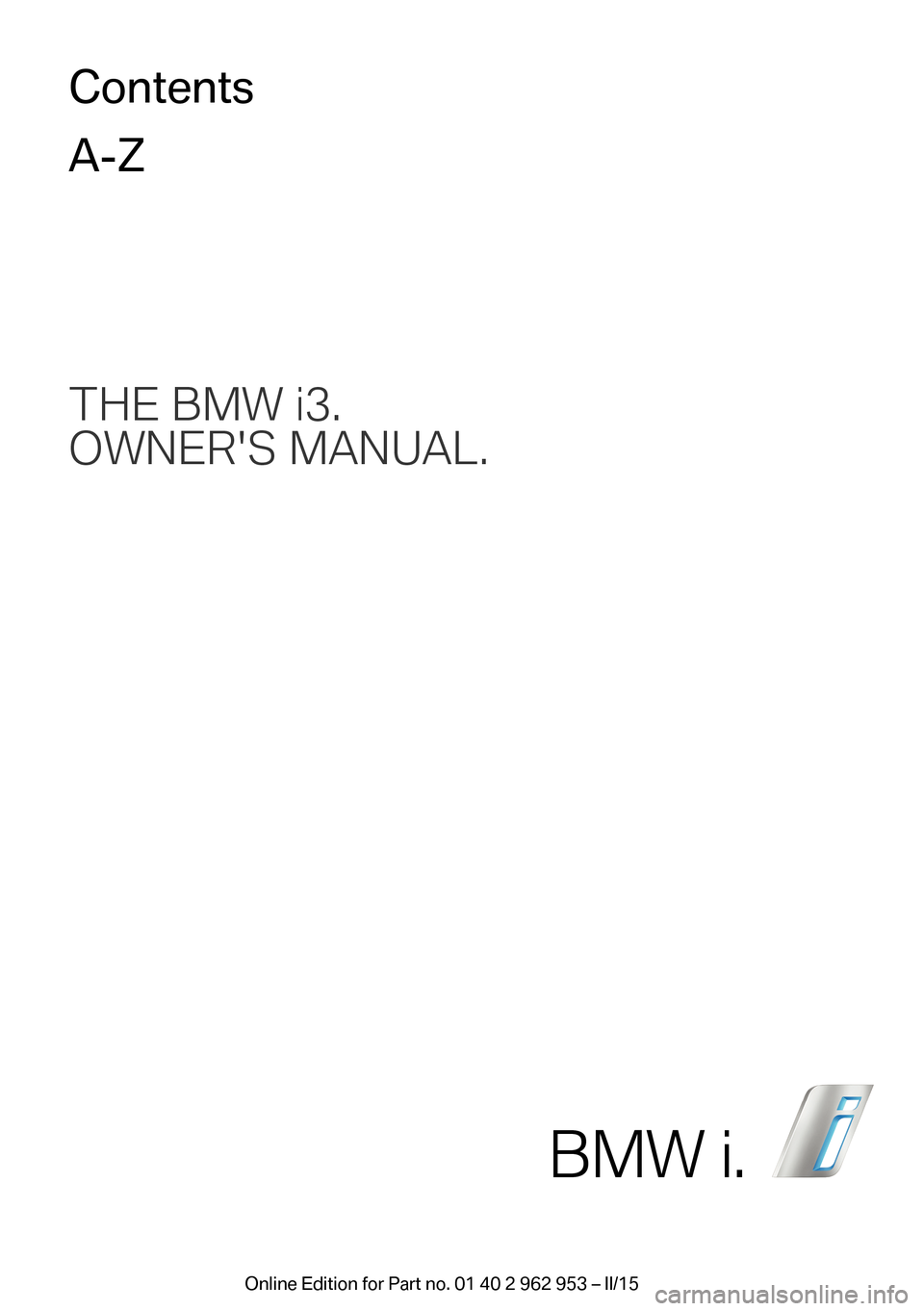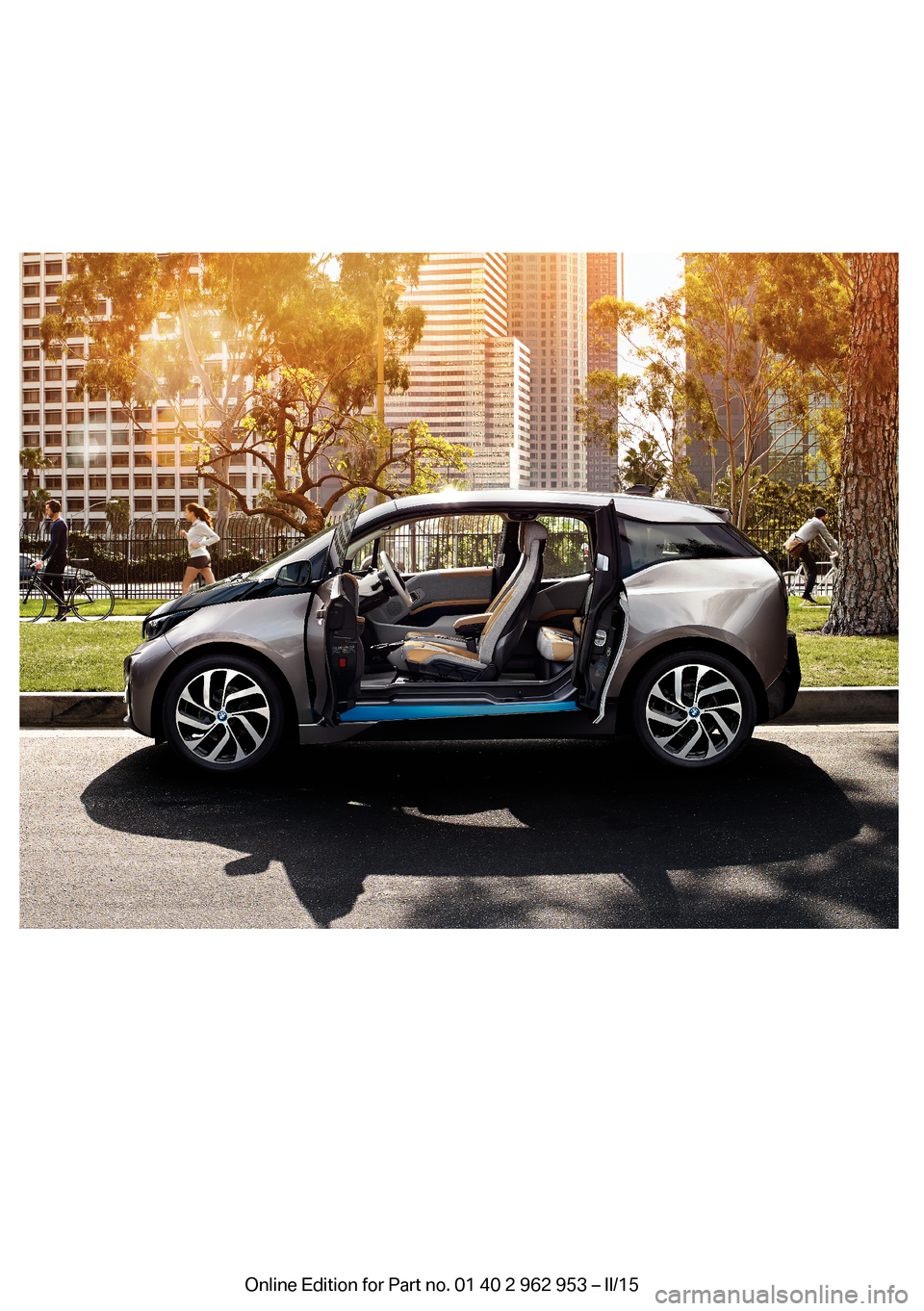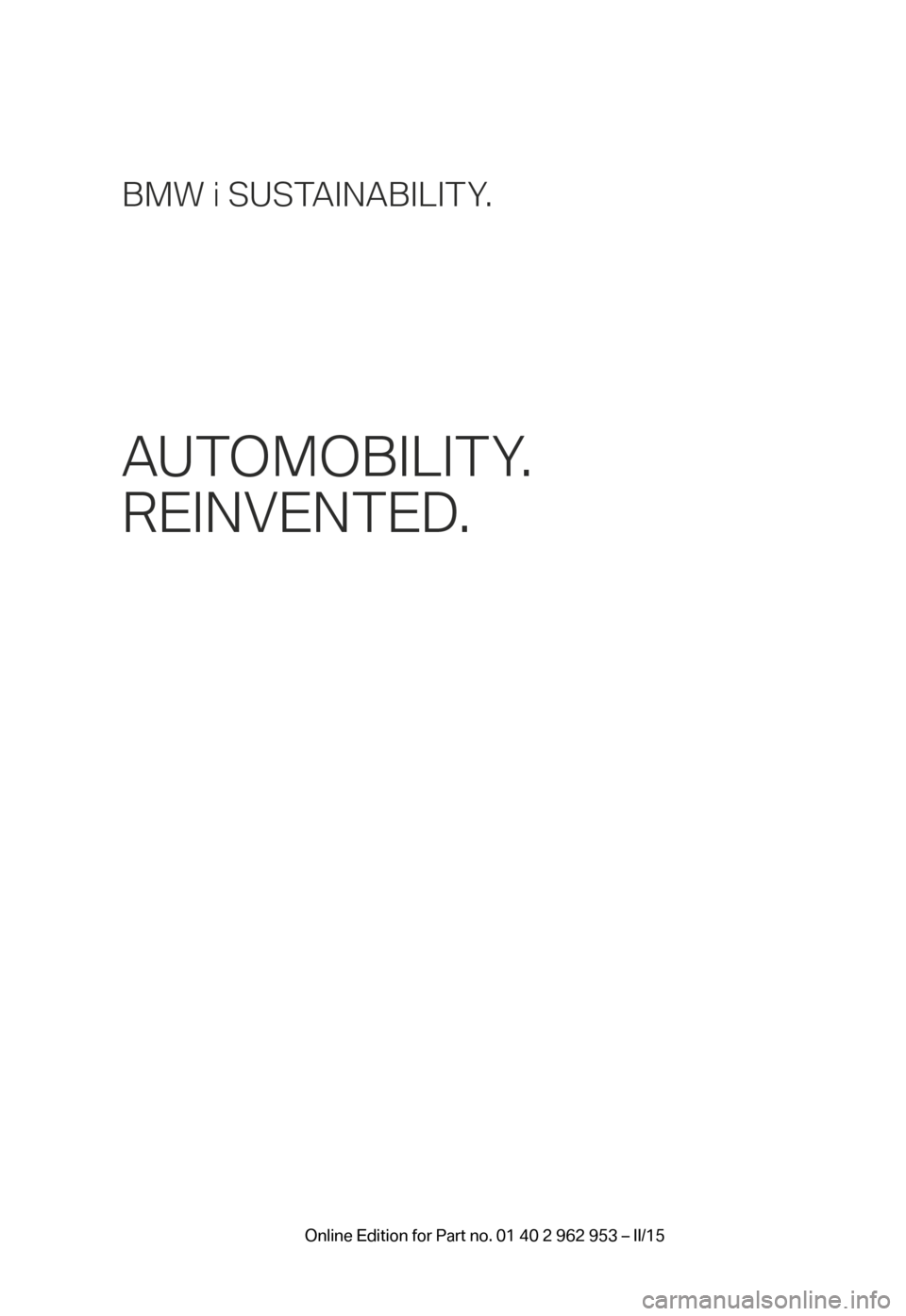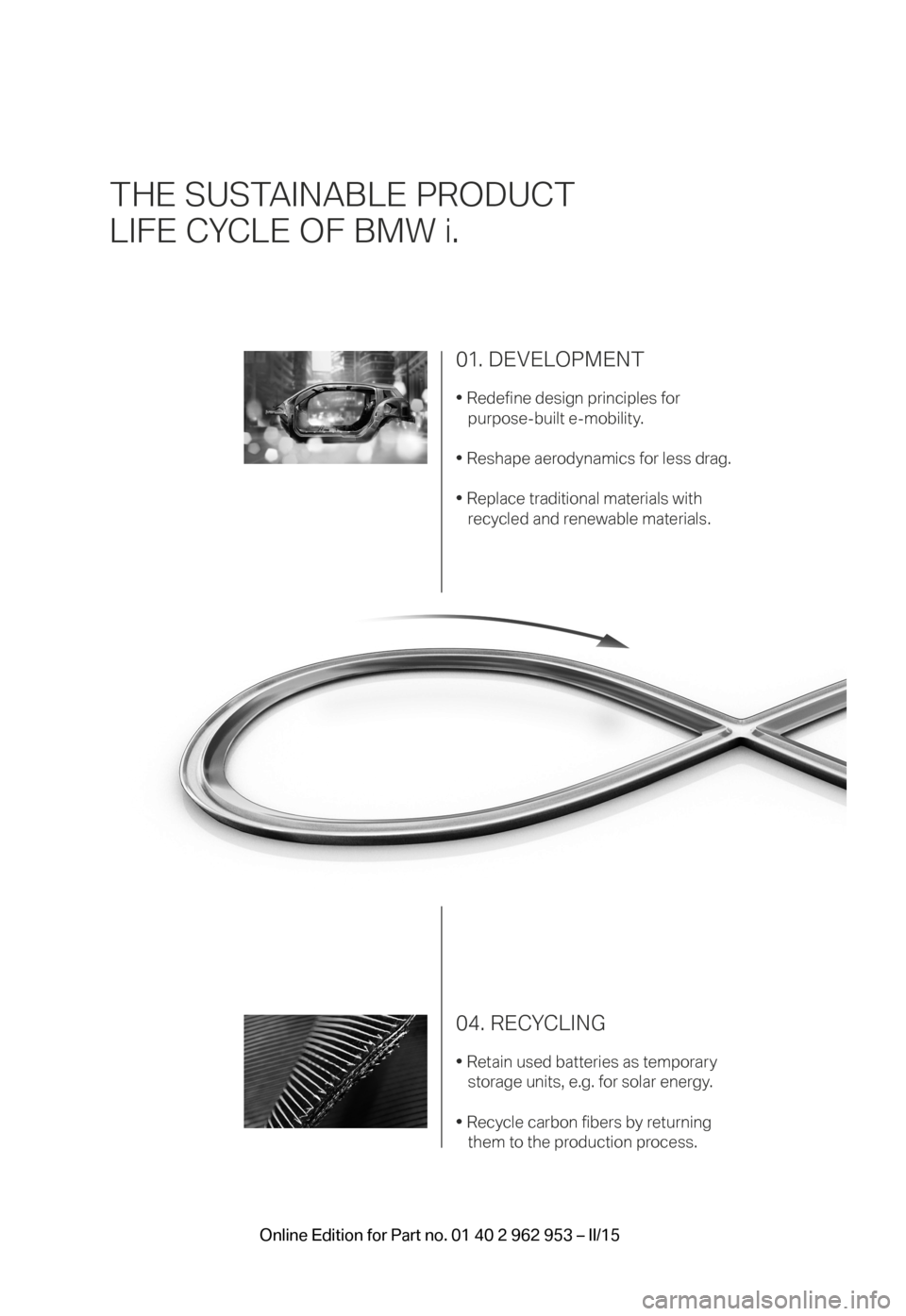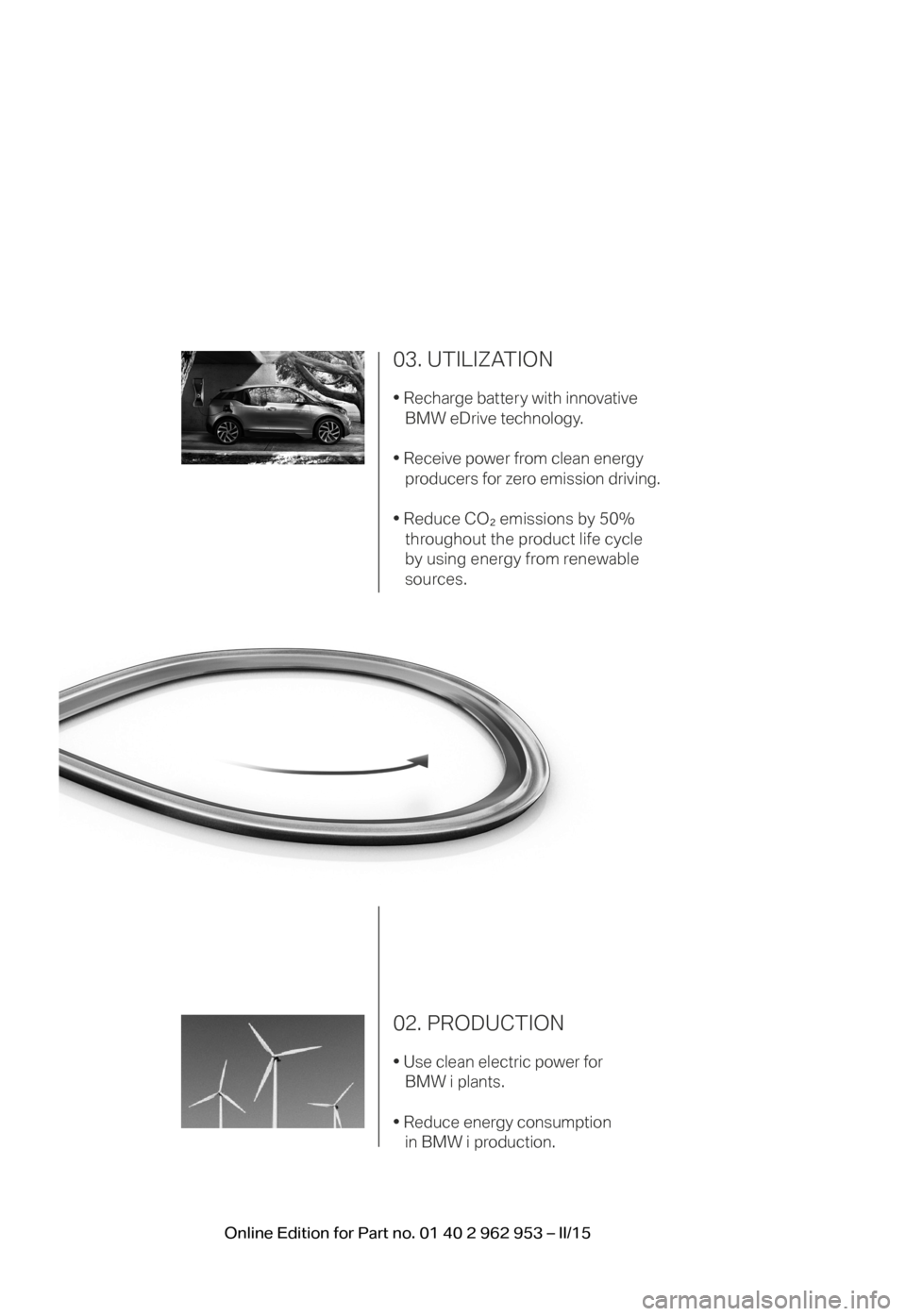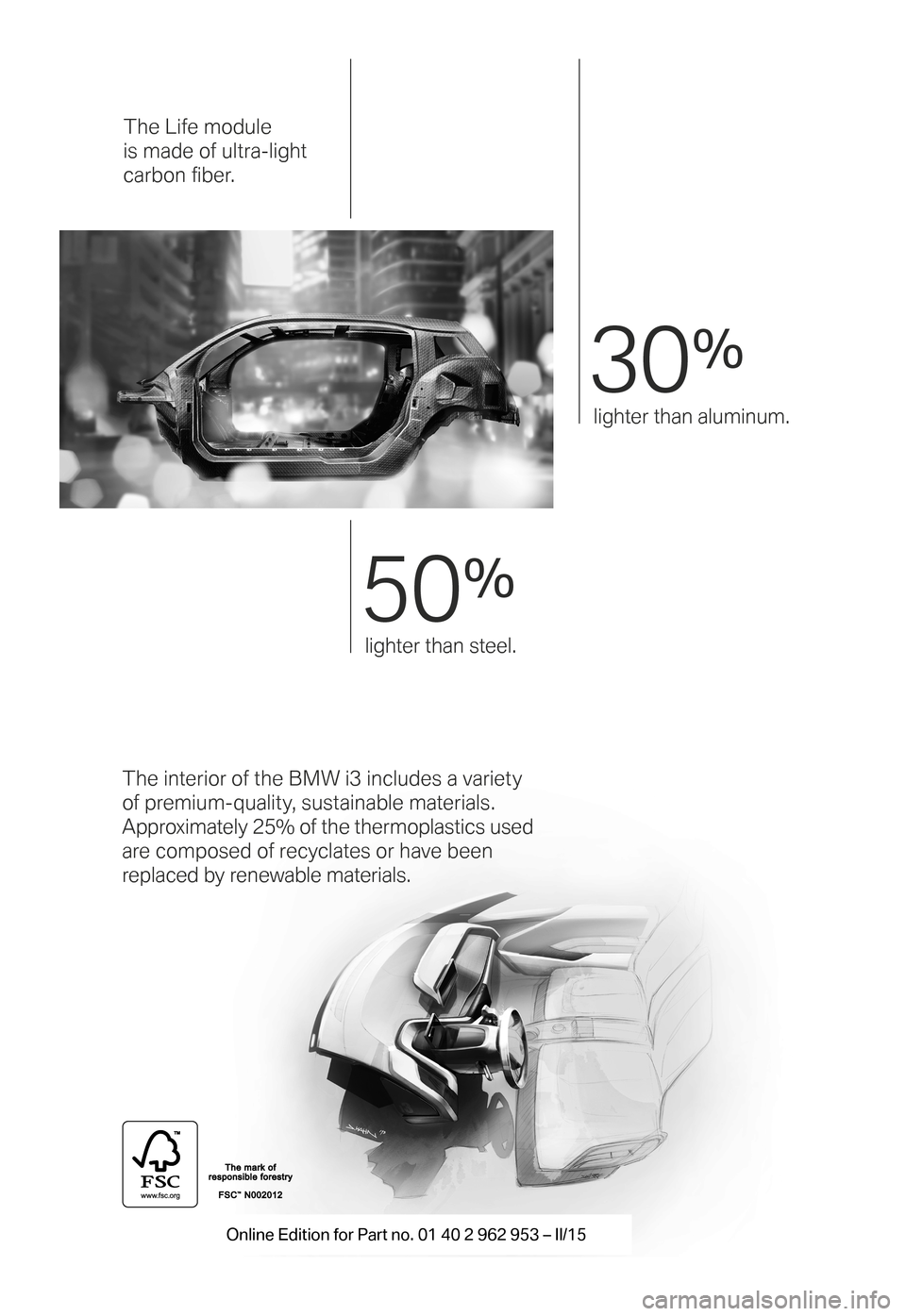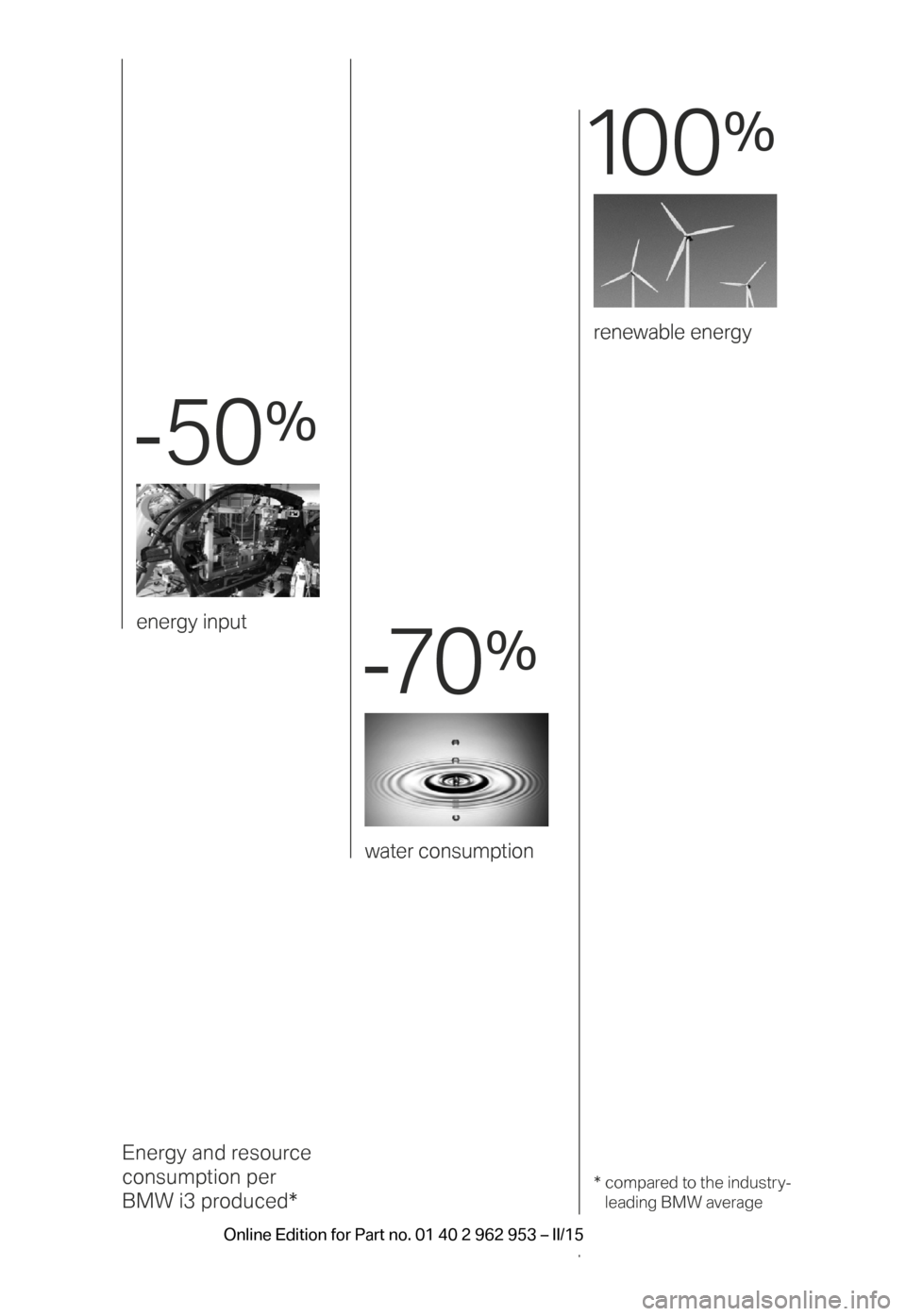BMW I3 2014 I01 Owner's Manual
Manufacturer: BMW, Model Year: 2014,
Model line: I3,
Model: BMW I3 2014 I01
Pages: 230, PDF Size: 29.93 MB
BMW I3 2014 I01 Owner's Manual
I3 2014 I01
BMW
BMW
https://www.carmanualsonline.info/img/1/2675/w960_2675-0.png
BMW I3 2014 I01 Owner's Manual
Trending: bluetooth, weight, ad blue, deactivate airbag, towing, key, Window
Page 1 of 230
THE BMW i3.
OWNER'S MANUAL.ContentsA-Z
BMW i.
Page 2 of 230
Page 3 of 230
BMW i SUSTAINABILITY.
AUTOMOBILITY.
REINVENTED.
BMW_i3_Bedienungseinleger_210x138mm_us_lektoriert_RZ.indd 122.01.14 15:19
Page 4 of 230
THE SUSTAINABLE PRODUCT
LIFE CYCLE OF BMW i.
01. DEVELOPMENT
• Redefine design principles for
purpose-built e-mobility.
• Reshape aerodynamics for less drag.
• Replace traditional materials with recycled and renewable materials.
04. RECYCLING
• Retain used batteries as temporar ystorage units, e.g. for solar energy.
• Recycle carbon fi bers by returning them to the production process.
BMW_i3_Bedienungseinleger_210x138mm_us_lektoriert_RZ.indd 222.01.14 15:19
Page 5 of 230
03. UTILIZATION
• Recharge batter y with innovative BMW eDrive technology.
• Receive power from clean energy producers for zero emission driving.
• Reduce CO
2 emissions by 50%
throughout the product life cycle
by using energy from renewable
sources.
02. PRODUCTION
• Use clean electric power for BMW i plants.
• Reduce energy consumption in BMW i production.
BMW_i3_Bedienungseinleger_210x138mm_us_lektoriert_RZ.indd 322.01.14 15:19
Page 6 of 230
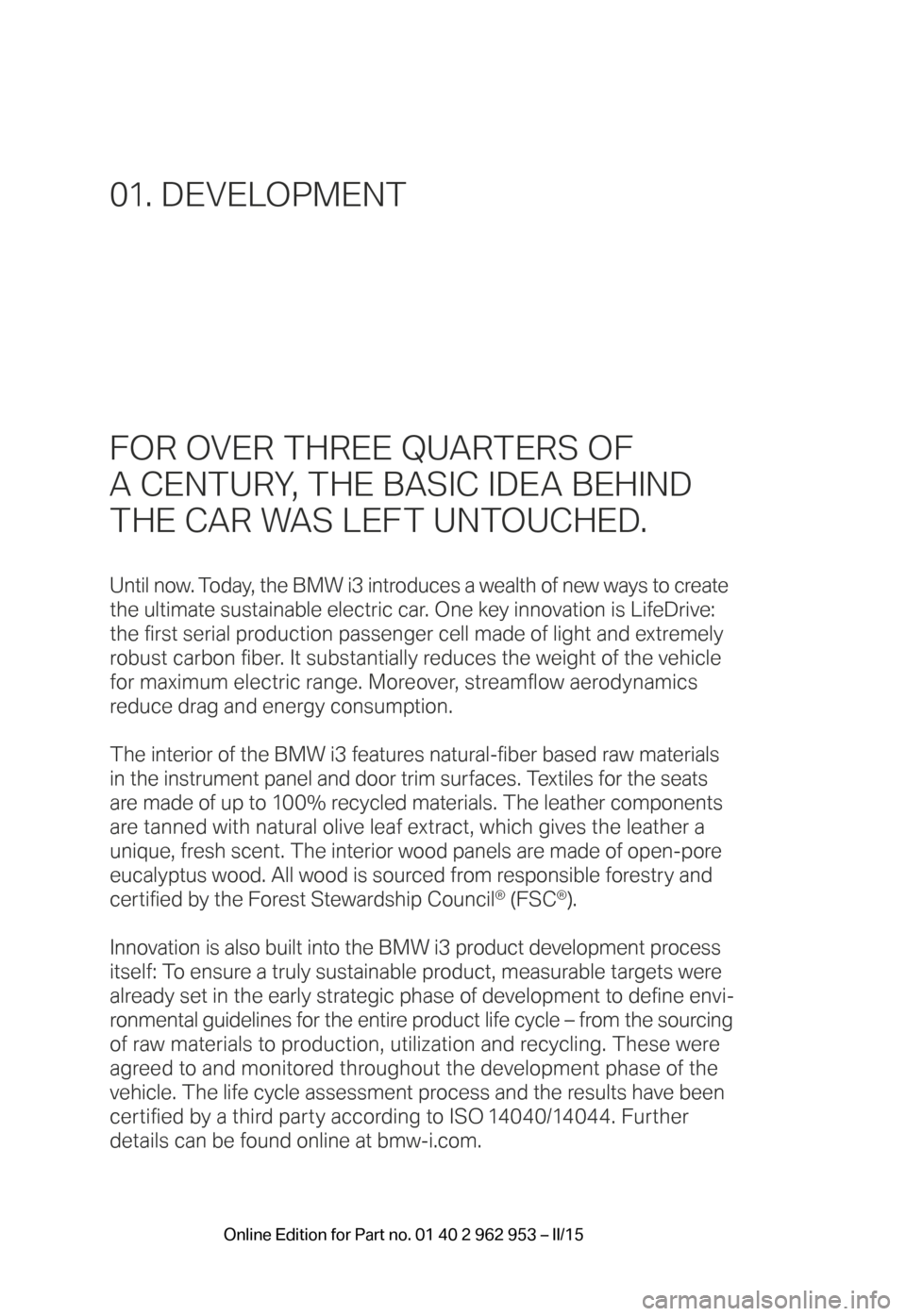
FOR OVER THREE QUARTERS OF
A CENTURY, THE BASIC IDEA BEHIND
THE CAR WAS LEFT UNTOUCHED.
Until now. Today, the BMW i3 introduces a wealth of new ways to create
the ultimate sustainable electric car. One key innovation is LifeDrive:
the first serial production passenger cell made of light and extremely
robust carbon fiber. It substantially reduces the weight of the vehicle
for maximum electric range. Moreover, streamflow aerodynamics
reduce drag and energy consumption.
The interior of the BMW i3 features natural-fiber based raw materials
in the instrument panel and door trim surfaces. Textiles for the seats
are made of up to 100% recycled materials. The leather components
are tanned with natural olive leaf extract, which gives the leather a
unique, fresh scent. The interior wood panels are made of open-pore
eucalyptus wood. All wood is sourced from responsible forestry and
certified by the Forest Stewardship Council
® (FSC®).
Innovation is also built into the BMW i3 product development process
itself: To ensure a truly sustainable product, measurable targets were
already set in the early strategic phase of development to define envi -
ronmental guidelines for the entire product life cycle – from the sourcing
of raw materials to production, utilization and recycling. These were
agreed to and monitored throughout the development phase of the
vehicle. The life cycle assessment process and the results have been
certified by a third party according to ISO 14040/14044. Further
details can be found online at bmw-i.com.
01. DEVELOPMENT
BMW_i3_Bedienungseinleger_210x138mm_us_lektoriert_RZ.indd 422.01.14 15:19
Page 7 of 230
The interior of the BMW i3 includes a variety
of premium-quality, sustainable materials.
Approximately 25% of the thermoplastics used
are composed of recyclates or have been
replaced by renewable materials.
The Life module
is made of ultra-light
carbon fi ber.
lighter than steel.lighter than aluminum.
5 0
%
30
%
BMW_i3_Bedienungseinleger_210x138mm_us_lektoriert_RZ.indd 522.01.14 15:19
Page 8 of 230
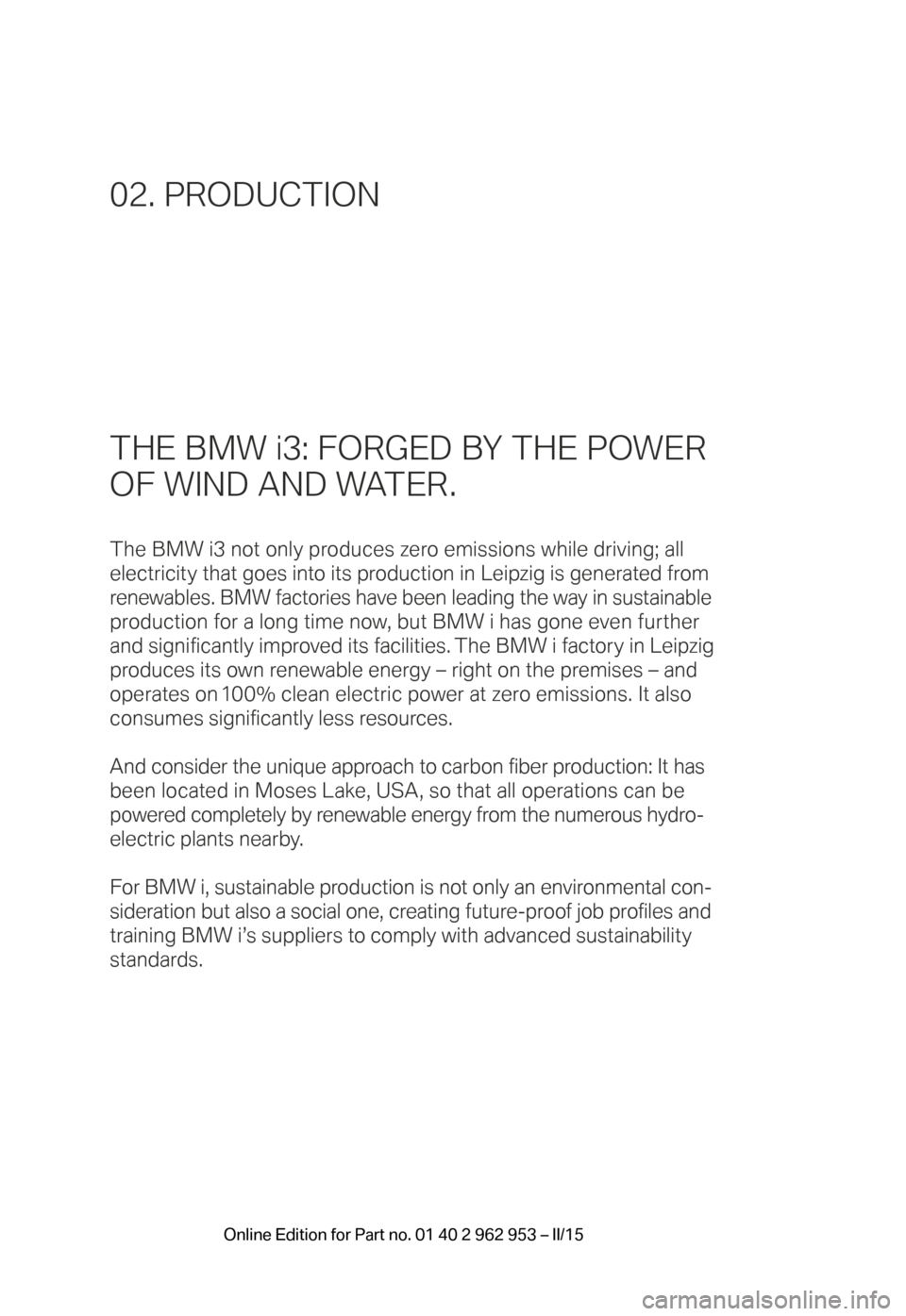
THE BMW i3: FORGED BY THE POWER
OF WIND AND WATER.
The BMW i3 not only produces zero emissions while driving; all
electricity that goes into its production in Leipzig is generated from
renewables. BMW factories have been leading the way in sustainable
production for a long time now, but BMW i has gone even further
and significantly improved its facilities. The BMW i factory in Leipzig
produces its own renewable energy – right on the premises – and
operates on 100% clean electric power at zero emissions. It also
consumes significantly less resources.
And consider the unique approach to carbon fiber production: It has
been located in Moses Lake, USA, so that all operations can be
powered completely by renewable energy from the numerous hydro-
electric plants nearby.
For BMW i, sustainable production is not only an environmental con -
sideration but also a social one, creating future-proof job profiles and
training BMW i’s suppliers to comply with advanced sustainability
standards.
02. PRODUCTION
BMW_i3_Bedienungseinleger_210x138mm_us_lektoriert_RZ.indd 622.01.14 15:19
Page 9 of 230
Energy and resource
consumption per
BMW i3 produced*
* compared to the industr y-leading BMW average
renewable energy
energy input water consumption
10 0
%
- 5 0
%
- 7 0
%
BMW_i3_Bedienungseinleger_210x138mm_us_lektoriert_RZ.indd 722.01.14 15:19
Page 10 of 230
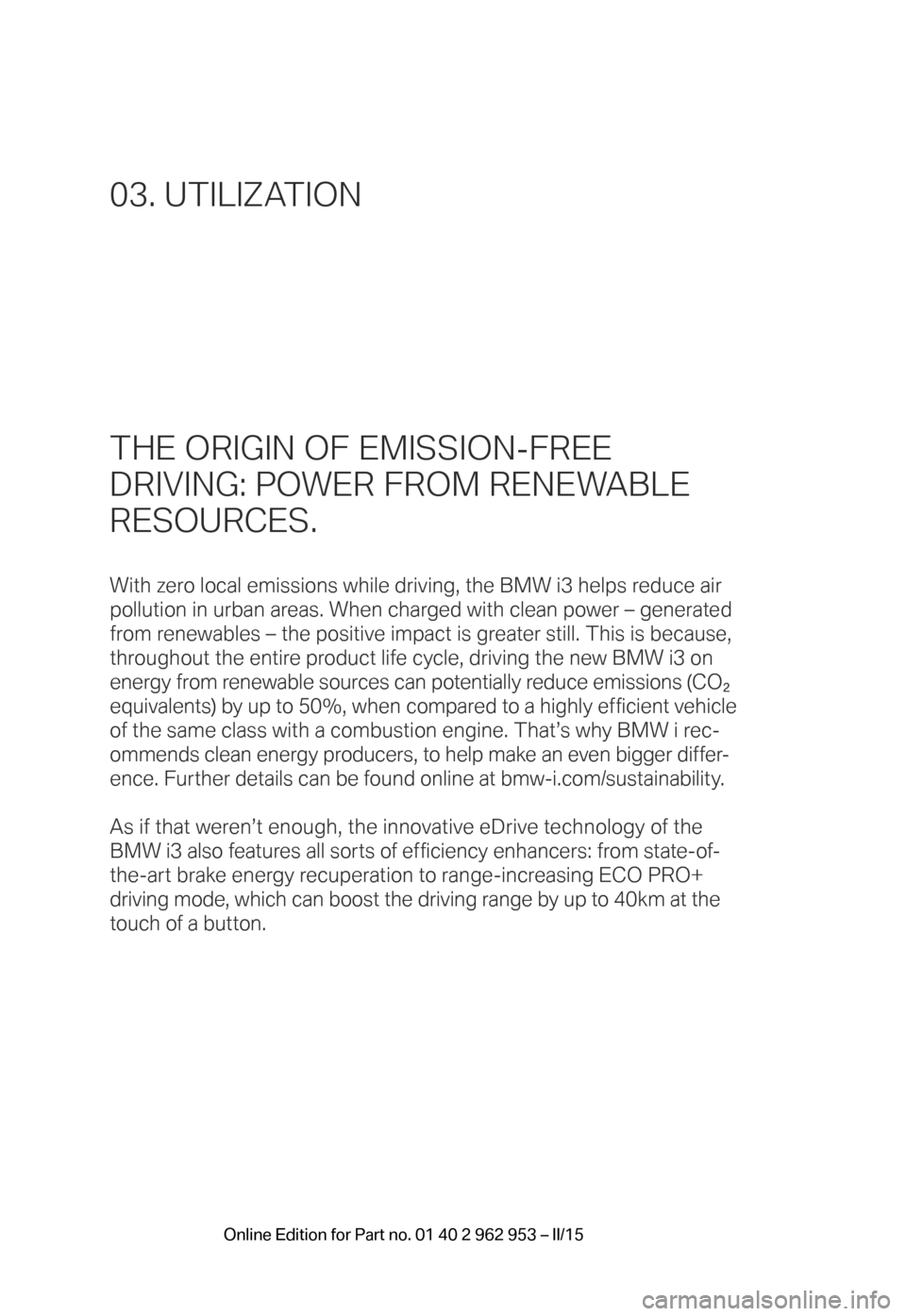
THE ORIGIN OF EMISSION-FREE
DRIVING: POWER FROM RENEWABLE
RESOURCES.
With zero local emissions while driving, the BMW i3 helps reduce air
pollution in urban areas. When charged with clean power – generated
from renewables – the positive impact is greater still. This is because,
throughout the entire product life cycle, driving the new BMW i3 on
energy from renewable sources can potentially reduce emissions (CO
2
equivalents) by up to 50%, when compared to a highly efficient vehicle
of the same class with a combustion engine. That’s why BMW i rec -
ommends clean energy producers, to help make an even bigger differ -
ence. Further details can be found online at bmw-i.com/sustainability.
As if that weren’t enough, the innovative eDrive technology of the
BMW i3 also features all sorts of efficiency enhancers: from state-of-
the-art brake energy recuperation to range-increasing ECO PRO+
driving mode, which can boost the driving range by up to 40km at the
touch of a button.
03. UTILIZATION
BMW_i3_Bedienungseinleger_210x138mm_us_lektoriert_RZ.indd 822.01.14 15:19
Trending: fuel type, winter tires, rims, Window, ignition, tires, ECU
